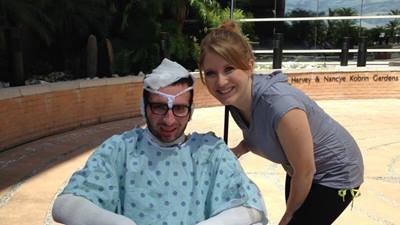In June of 2014, I was trimming trees at a local church, which just happened to be across the street from a hospital. While I was working, a power line arched over to the metal bucket I was standing in and shot 14,000 volts of electricity through my body. (For perspective, a Taser delivers about 1,200 volts to the body.)
I had fourth- and fifth-degree burns. The power of that electrocution burned the skin from my upper body, leaving my sternum, clavicle, rib cage, chest and arms completely exposed. My wife, Bobbye Jean, was at the church too, and as emergency medical technicians (EMTs) arrived and began working on me, they initially held her back. But as my vital signs decreased, they let her come to my side to say goodbye, even as they continued caring for me.
Life-Saving Decision: Which Hospital to Go to?
The EMTs had a choice to make: take me to the nearest hospital, which was across the street, or take a few minutes more to airlift me to Orlando Health Orlando Regional Medical Center (ORMC) and its Level One Trauma Center. I wouldn’t have survived a trip to a more distant trauma center in Gainesville or Miami. And although I could die on the way to Orlando Health ORMC, if I made it, I could get the most comprehensive care. They decided to get me to Orlando Health ORMC — a decision that no doubt saved me.
The hospital across the street was a good hospital, but a Level One Trauma Center is a regional resource that has 24-hour, in-house coverage by general surgeons as well as prompt availability of specialists. A lot of people assume that the trauma designation is based on the size of a hospital, but it’s based more on the hospital’s depth and breadth of expertise, resources and the immediacy of providing care.
When I arrived at Orlando Health ORMC, a team of doctors was waiting for me, and I was taken into surgery immediately. That surgery lasted eight hours and I was in a coma for a week. Even when I woke up, my life was still at-risk.
Aftermath of Burns
With burns the biggest reason people die is from infection. I had fourth- and fifth-degree burns, which means the injury extended beyond the skin to the fat and muscle. Because so much trauma had been inflicted upon my body, doctors warned my family that I could have brain, kidney and heart damage. The burns to my arms were so severe, I had no circulation and without that, muscles would die and infection would spread. The doctors told my family that they would need to amputate my arms at the shoulders. But at midnight before the morning of my scheduled surgery, an Orlando Health ORMC specialist was called in to consult. After trying a different procedure, he was able to restore circulation to my arms. I am so grateful to him. If Orlando Health ORMC, as a Level One Trauma Center, had not had access to this specialist in the middle of the night, I would not be able to hold my three children as I can now.
Recovery from burns and other trauma is a slow process. It’s two steps forward and one step back.
In those first days, doctors went in daily to remove muscle that had died so it would not become toxic and go into my bloodstream, causing sepsis. The team of doctors consulted on a game plan to get me back together, using skin grafts. Even though I have an uncommon blood type, the blood bank at the Level One Trauma Center always had what I needed. I spent three months in the hospital, and it wasn’t until the second month that the odds for recovery turned in my favor. The recovery process continued with 70 follow-up surgeries and physical therapy sessions for years after the accident.
The skill and expertise of the medical staff at Orlando Health ORMC were instrumental in keeping me alive. But it was more than their experience — it was their care. When you spend three months in a hospital, it becomes your whole world and the staff becomes your family. The difference between a nurse or doctor coming into your room and doing a checklist job versus coming in with compassion changes everything. I wasn’t just a patient, I was a person.
The New Normal
Nearly five years after the accident, I have three beautiful kids and an amazing wife, and I travel to corporate events, leadership events and churches to share a message. The scars I have on my arms are external for everyone to see, but the reality is, everybody faces challenges and everybody has scars. Some of the deepest ones that people carry around are unseen.
We can’t choose our challenges, but we can choose our attitude. We can choose our faith and we can choose how we navigate those waters and what we do afterward — how we bring meaning to what we’ve experienced by helping others who are also going through that. As I share my message, I know that Orlando Health ORMC is a big part of my story.
Choose to Stay in Touch
Sign up to receive the latest health news and trends, wellness & prevention tips, and much more from Orlando Health.
Sign Up for HealthBeat





